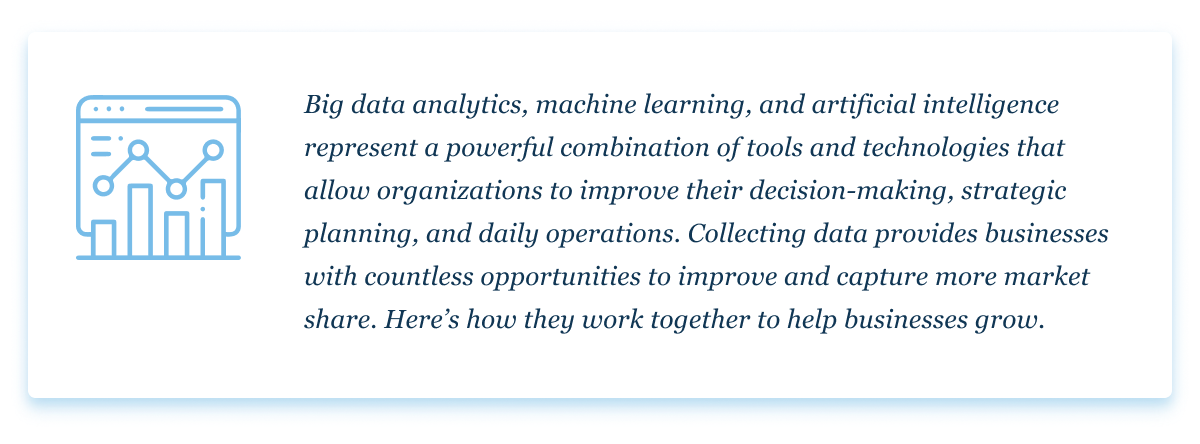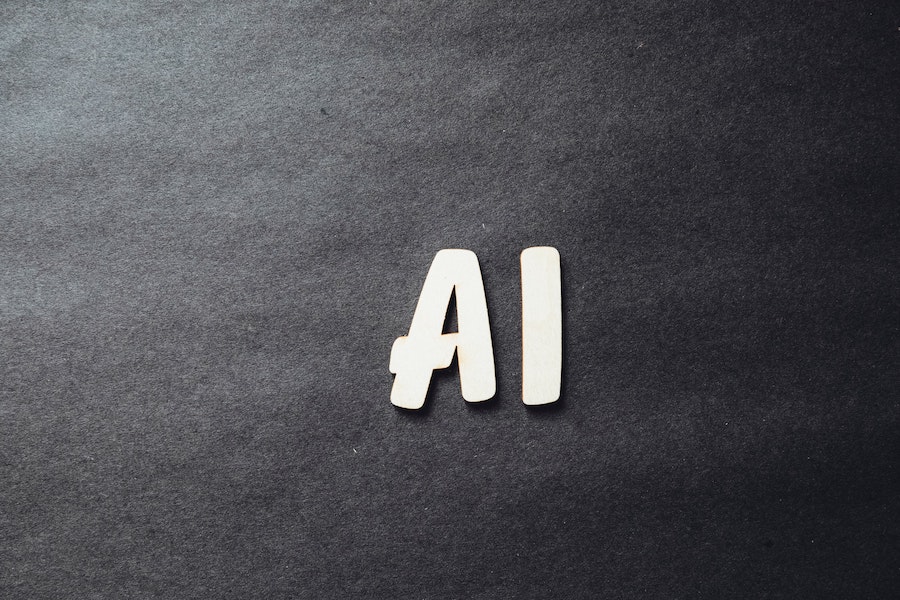Big data, artificial intelligence, machine learning. You hear these terms all the time, now that data is the world’s hottest commodity. But how do Big data and artificial intelligence work together to solve problems for businesses?

Big data and Artificial Intelligence: are they the same?
Big data analytics and artificial intelligence are frequently discussed together. This isn’t surprising, since they are both used to leverage the power of data for businesses. However, they are not the same thing, although there is a close relationship between AI and Big data.
There is a symbiotic relationship between Big data, machine learning, and artificial intelligence. Big data has influenced the rise of AI in the sense that artificial intelligence requires data to function. Humans collect data as we grow, learning from the world around us and changing our insights based on prior knowledge. Artificial intelligence must rely on the purposeful input of data, at least initially. Some systems use machine learning to adapt and “learn” based on new data that is received over time.
With the right data input, AI can help analysts use Big data to its best advantage. In the last decade, these two technologies have advanced side by side, helping to improve one another.

Source: Unsplash
What are Big data analytics and Artificial Intelligence?
Because they are often discussed as a unit, it’s easy to assume that one cannot exist without the other. But it’s important to know that Big data and AI are distinct technologies with distinct uses, that just happen to work very well together, and frequently rely on one another. The difference between Big data and artificial intelligence is huge, however—Big data is simply a collection of unstructured information, while artificial intelligence can be used to process and find information.
Big data
Big data refers to extremely large datasets that generally cannot be analyzed without the help of computer programs. To be considered Big data, there has to be a large amount, many sources or variety, and a high rate of collection. These are known as the three “V”s:
- Volume
- Variety
- Velocity
Big data analytics can be used to extract useful information from these datasets, identifying patterns, trends, and other insights that can be used in a variety of contexts. Huge collections of information from different sources can’t do much on their own, but they become extremely powerful when paired with tools that leverage artificial intelligence.
Data scientists are tasked with extracting insights from these large datasets and use a variety of software tools to find specific associations and predictions. Without these software tools, Big data would be impossible to work with effectively. It is extremely labor-intensive to analyze data manually, and the massive amount that is being produced would be too much for any human team to cope with.
Artificial Intelligence
Artificial intelligence is a completely separate discipline from Big data, although it relies on data to function. The term artificial intelligence is used to describe technology that is designed to mimic human intelligence. Artificial intelligence does rely on data, but it is not a subset of Big data — it is a unique discipline. Many of today’s AI systems can use natural language processing to understand large amounts of text or spoken words, which is why virtual assistants like Siri and Alexa can perform a variety of tasks.

Source: Unsplash
There are several branches of modern artificial intelligence, including machine learning and deep learning. The narrower forms of AI cannot do anything they are not specifically programmed to do. Most of the AI technology we have today is within this scope, but technology is improving all the time and learning forms of AI are becoming stronger.
AI provides analysts with the power to make sense of Big data. They are separate but rely on one another for their full effectiveness and functionality.
Why Big data is important for AI advancement
Big data and AI go hand in hand. Without data, there would be no artificial intelligence. Without artificial intelligence, all that raw data wouldn’t be usable, as there would be no way to process it efficiently, let alone in real-time. Data preparation is much easier with the use of AI tools.
AI has become much more powerful over the last decade. Thanks to the amount of data being collected, combined with improved algorithms, artificial intelligence has become more helpful and precise, allowing data analysts to process even more data that can be used for business success.
Big data has allowed the field of AI to advance more quickly. The need to analyze large datasets has created practical applications for artificial intelligence and nearly unlimited data for the technology to process. This has also created new opportunities for machine learning from Big data.

Source: Unsplash
About machine learning
Machine learning describes AI systems that use a learning algorithm to improve over time. Initially, data is provided for the system, allowing it to gain a baseline understanding of the task and information that is available. Beyond this, the system will adapt using its algorithm and new data inputs to become more effective over time.
ML is currently only able to work on specific tasks. Only related types of data will help the system get smarter. Providing other types of data will not produce a response. Although this might be limiting, machine learning is still extremely helpful for analyzing data without human intervention.
The state of the Big data industry
The Big data industry is growing very quickly. It is estimated that by 2027, the global market will grow to $103 billion. As the industry has grown, the field of artificial intelligence has grown even faster and is forecasted to reach $126 billion by 2025.
In the world of Big data analytics and artificial intelligence, big players like IBM, Intel, Microsoft dominate. These large companies have the resources and talent to create groundbreaking technology in Big data and AI. Big data application development isn’t just limited to large corporations, however. There are plenty of startups and SMEs in Big data, artificial intelligence, machine learning, and data protection developing products to improve the collection and processing of large datasets.
The amount of data being collected by organizations in every industry has made the Big data industry critically important. Companies are actively recruiting Big data experts so they can gain a competitive edge over other businesses in their markets. However, finding qualified talent can sometimes be a challenge, as these roles require knowledge of programming and statistics in addition to “soft skills” like communication.
Why we use Big data — benefits for businesses
Big data has changed the way organizations operate. In the past, decisions were made based on human instinct, experience, and experimentation. Data analytics takes some of the guesswork out of strategic planning, allowing for better use of resources. Businesses are using Big data in so many specific ways, but there are a few main benefits an organization can gain from leveraging data:

With all the data available today, there’s no good reason NOT to use Big data in organizational strategy. Data-driven leadership can help companies excel in a variety of ways and in a variety of industries. While companies like Netflix and UPS are known for their pioneering use of data, nearly all large companies today are using it for their benefit.
Can all businesses benefit from Big data & AI?
As data can be collected in every industry, there are endless applications for analytics and AI. Nearly any business can benefit from using Big data tools to improve its overall performance. Here are just a few of the many industries that have benefitted from AI and data analytics:

Looking across industries, you can see how data is being used differently based on the context of the industry. Big data and artificial intelligence in healthcare, for instance, have been used to improve diagnostics, reduce errors, and increase efficiency — all of which improve the patient experience and reduce costs for healthcare organizations. Big data precision medicine is also on the rise and it’s enhancing patient outcomes and helping us better understand unique healthcare needs.
In retail, Big data use is mostly focused on the supply chain and on understanding customer behavior. Data can be used to personalize special offers and retarget online shoppers, offering different types of recommendations based on the individual’s past behavior.
The manufacturing industry has also benefited greatly from Big data. Data can be collected and analyzed at every stage of the process, from the supply chain to quality control. Manufacturers can maintain quality while cutting costs using data analytics.
It’s hard to think of an industry that could not benefit from using data and AI to improve its processes and performance. As these tools have improved, more and more businesses are seeing the benefits of investing in Big data.
The push for data-driven business culture
Moving toward a data-driven culture can benefit just about any company in the long run. It is much easier to create goals and determine progress with solid data available. Tracking performance helps reduce uncertainty and gives leaders powerful tools to work with.
Another reason that more companies are prioritizing a data-driven culture is that it provides objective information that can make tough decisions easier. It’s all too easy to continue using the same ineffective strategies if you don’t have data to give you an alternative. If a company is exploring two promising opportunities, data might provide the insight business leaders need to be confident in their decision.
A data-driven culture also provides a powerful communication tool. Communication breakdowns lead to lots of problems in the workplace, affecting morale, productivity, and causing costly turnover. Business leaders who use data can use it to communicate with team members, provide them with appropriate goals and challenges, and monitor their progress without removing their autonomy.
Some employees who are used to the status quo or may not be putting in the appropriate amount of effort may balk at switching to a data-driven culture. However, relying on data can be a huge step forward in terms of growth and performance.
Accessibility of Big data analytics using AI
In the last decade or so, Big data and AI have become much more accessible for organizations of all sizes and types. Data science solutions are now accessible to organizations that cannot afford to hire their own experts but still want to unlock their business’s full potential.
There are companies providing these technologies in user-friendly formats for specific functions, such as understanding customer behavior or recruiting. Big data service companies take the guesswork out of setting up artificial intelligence and Big data, ensuring that there are no missed steps.

Source: Unsplash
Companies that want to leverage the power of data must understand which data sources will be most helpful for their business goals. Data analytics are only powerful if there is a defined purpose for their use. A company that wants to become more competitive must have clear goals for their data collection and processing, such as:

Small businesses that choose to use these tools and have specific goals will generally gain a competitive edge within their market. However, as AI and ML have not advanced to the point that they can operate fully independently, someone on staff will need to know enough about the tools to ensure that they are being used properly.
Larger organizations will generally need a data science team with highly-trained professionals to ensure that their data is being used effectively. Today, it’s an investment that is necessary to keep up with other large corporations and ensure that a company stays competitive.
The future of Big data, AI, and business insights
As a global community, we are creating huge amounts of data online every day, every hour, every minute, and every second. Datasets are only going to get bigger. Not all of that data will change the world, but it is helping change the world of business and improve many areas of our lives.
Thanks to the influence of AI and machine learning, data scientists are able to gain insights we could only dream of just a few decades ago. With AI and Big data helping each other improve, we can expect the technology to get even bigger in the coming years as the market grows and spurs new innovations.
We might be a long way from strong AI that is as intelligent as we are. But the tools we have access to now will help shape the future of the industry and help business leaders discover new strategies. Entrepreneurs will have more data than ever to help them fuel the economy with new businesses. And artificially intelligent systems will continue to help us make sense of the world around us.
Author bio
Ryan Ayers has consulted a number of Fortune 500 companies within multiple industries including information technology and Big data. After earning his MBA in 2010, Ayers also began working with start-up companies and aspiring entrepreneurs, with a keen focus on data collection and analysis.
Disrupt your business with Big data and AI
For more information on all topics for Big Data and BI, please take a look at our blog.



